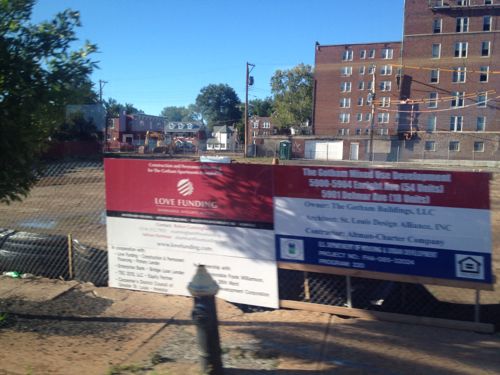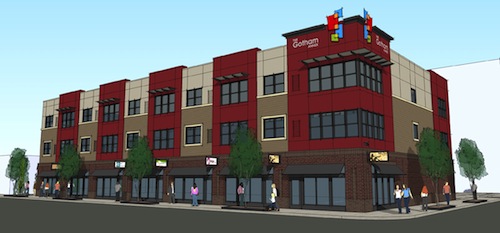2013: Gotham & Delmar Apartments
Recently, while riding the #97 MetroBus, I passed by the NW corner of Delmar Blvd & Hamilton Ave (map) just east of the Delmar MetroLink station and noticed signs on a vacant corner.

Turns out the project will include the renovation of the historic Gotham apartment building in the background dating from 1926 as well as new construction facing Delmar:
Gotham and Delmar Apartments will consist of a substantially revitalized building recently certified by the National Park Service as a historic structure, and a newly constructed building on the same site. The transaction enables the property’s developers, Delmar Properties Management and Construction LLC, to obtain a fixed, low-rate, non-recourse loan for the period of construction and for a 40-year term once the buildings are completed. Many of the improvements being made to the existing building are designed to make the apartment units and public spaces more energy efficient and help reduce residents’ monthly expenses. (source)
The renovation of the Gotham building will reduce its unit count to 54 apartment units from 66, while the new Delmar building will consist of 18 residential units and a number of first-floor commercial suites for office or retail use. (source)
Very good news for a part of Delmar that hasn’t seen the level of development as the other side of the MetroLink line.

Hopefully we will see many more new mixed-use buildings planned for Delmar as the Loop Trolley construction begins.
— Steve Patterson
I Dig it. I like the fact that it’s on the North(!) side of Delmar, I like the fact that it’s on the (theoretical) street car route, I like the fact that it’s about a quarter mile (comfortable walking distance) from the eastern end of the Loop (the old defunct Wabash train station). Hopefully this is the first step in expanding the vibrancy of the Loop area eastward along Delmar. Could this be actual TOD in STL?
Also, I like the fact that it’s an actual urban building, mixed used (commericial and residential) built up to the street and respecting the street.
One, like it! Hope it’s successful and creates demand for more.
Two, to clarify, it looks like the old Gotham Building is on the SW corner of Hamilton & Enright, while the new Delamr Building will be across the alley, on the NW corner of Hamilton & Delmar.
And three, it’s interesting to watch the evolution of the site on http://www.historicaerials.com/ 1958 and 1971 shows an older, apparently two-story structure “holding the corner”. By 2002, the front third had been removed, obviously to provide off-street parking. No change in 2004, but by 2005, the entire structure is gone.
Well I’ll poop on the parade. I like the building, don’t get me wrong. But this seems to be the basic design….i.e. the condos /bread Co at the corner of Euclid & Forest Park and a few other places around town. So instead of something unique and different, we will end up with big box, cookie cutter home units.
It is rather generic, but I think getting the form right is more important than something unique that looks dated in a decade.
Really? Isn’t that the same argument that they use with the big boxes? In a decade then what? An argument that the city is too bland? Isn’t that part of the problem today? So the next time a developer proposes a project, we can use the “its more important than something unique” arguement???
No, we’ve had the form all wrong for decades now. The form must be right because we’ve learned a prototype retail box with some red brick is still just a box behind parking.
Still not convincing. Mater of fact….the Del Taco, now Starbucks…was unique AND dated.
Your basic premise is that changing the built environment will somehow convince most people that walking / using transit / biking / doing anything but driving is better than driving. I tend to think that the built environment reflects how most people choose to live their daily lives, in spite of what most of us “experts” think would be better for them. If “the form [has been] all wrong for decades now”, why is it so pervasive and accepted? Why is this type of development viewed to be “unique”, “different”, “special” or “better”? We’ve had options similar to these for many years. Some people like and choose them, some don’t and don’t. Many people, making many small choices, every day, is what creates the world we live in. Don’t get me wrong, I hope that this project is successful, I just have my doubts. Call me cynical, call me wrong, call me experienced, call me too pessimistic, the reality is only time will tell . . . .
No, I know that walking is human nature. It’s one of the first things we learn to do. People of all ages, races, incomes enjoy walking. Because of our built environment we’ve forced this activity into places like the mall or the path in the park. Put the typical American in Manhattan and they’ll walk more in a day than they would in a month. The environment makes a huge difference!!
Agree, but why is Manhattan, NY, dense and walkable, and why is most of Manhattan, KS and most of St. Louis, not dense and not very walkable? One reason – land values! It costs more money to go more dense, and money talks, both there and here. Most people in Manhattan don’t own cars and don’t drive cars because a) they simply can’t afford to (much like how they can’t afford large apartments, much less single-family homes), and b) congestion is great (a downside to density). It’s a classic case of supply and demand. Many people want to be in Manhattan (and are willing to “pay the price of admission”) while relatively few want to be here, nor are they willing (or able) to pay (any) more than what our “affordable” (on a national scale) real estate is fetching here. A double wide with a carport, a well and a septic tank will always be less expensive than an equal size unit in a mid-rise or high-rise building with an elevator and covered parking, EXCEPT where land costs are much higher than they are in 99% of Missouri!
Conversely, the land values in St. Louis are far less than in Manhattan because St. Louis is less dense/walkable. Over 1.5 million live in Manhattan with as many living in other boroughs of NYC. They pay huge prices for tiny spaces and the housing supply is strained due to demand. Meanwhile we lose young talent to denser cities because we’ve failed to offer the lifestyle so many desire. The market has spoken, the St. Louis region isn’t keeping up with increases in general population much less growth seen by more urban cities.
That makes no sense. St Louis was once dense/walkable, and much of that has been torn down. Why didn’t St Louis’ past density lead to high prices?
NYC is expensive because people are willing to pay for its unique job and cultural opportunities. Because it’s expensive, it is economically worthwhile to build densely. LA, despite not being dense, has similar opportunities to NYC (Hollywood, defense companies etc. – obviously less than NYC since it is smaller, but much more than St Louis) and is also expensive. Talent drains from St Louis to both of those places, just as it drains from Rolla and Cape Girardeau to St Louis. Out of NYC, LA, STL, and Rolla, only NYC has density, but in every case talent flows to the larger population center.
The St. Louis region isn’t seen as an environment attractive to the creative class.
From http://www.lincolninst.edu/subcenters/land-values/metro-area-land-prices.asp . . . . relative land values for the NYC, LA & St. Louis MSA’s: $225,422, $282,172 & $8,644, respectively! Throw in Portland at $103,956 and San Francisco at $565,181 and it’s pretty easy to see why sprawl is so predominant here. When land costs 12 times as much (in Portland), 25 times (NYC), 33 (LA) or 65 times as much (in San Francisco), then yes, density goes up. The biggest variable, besides employment and cultural amenities, is that the other areas are physically constrained, by large bodies of water or arbitrary urban growth boundaries (limited supply). Here, if you don’t like the price or the politics, you can just move on down the road until you find something more to your liking (essentially unlimited supply).
I hear whatt all you are saying and you all have great points,But i grew up there from 79-2006 and im loving this change i wish they would do something that is much differnt but as you all know stl we dont want to much differnt we want what the other cities have so we wont be out done……But sine i have move here to Atlanta im sing the same degin here and they have ben doing some major redevelopment of communities with all the same look so dont feel to bad…But i would like to see better quilty of homes to built around that area because i plan on moving back home in a couple years and i don want move back on the south side or to west co. to rasie my kids.